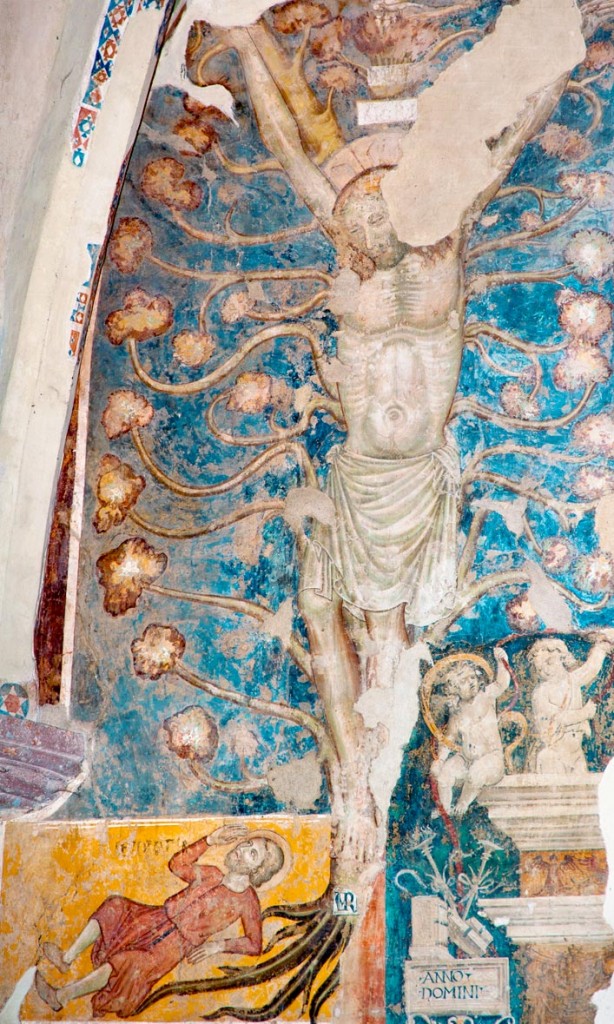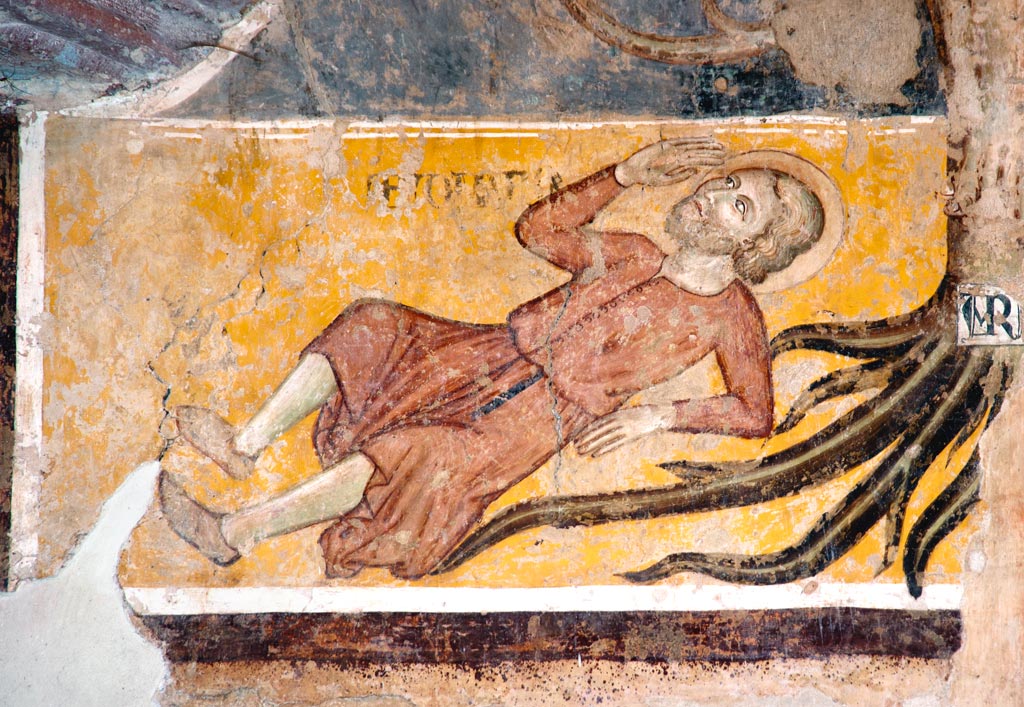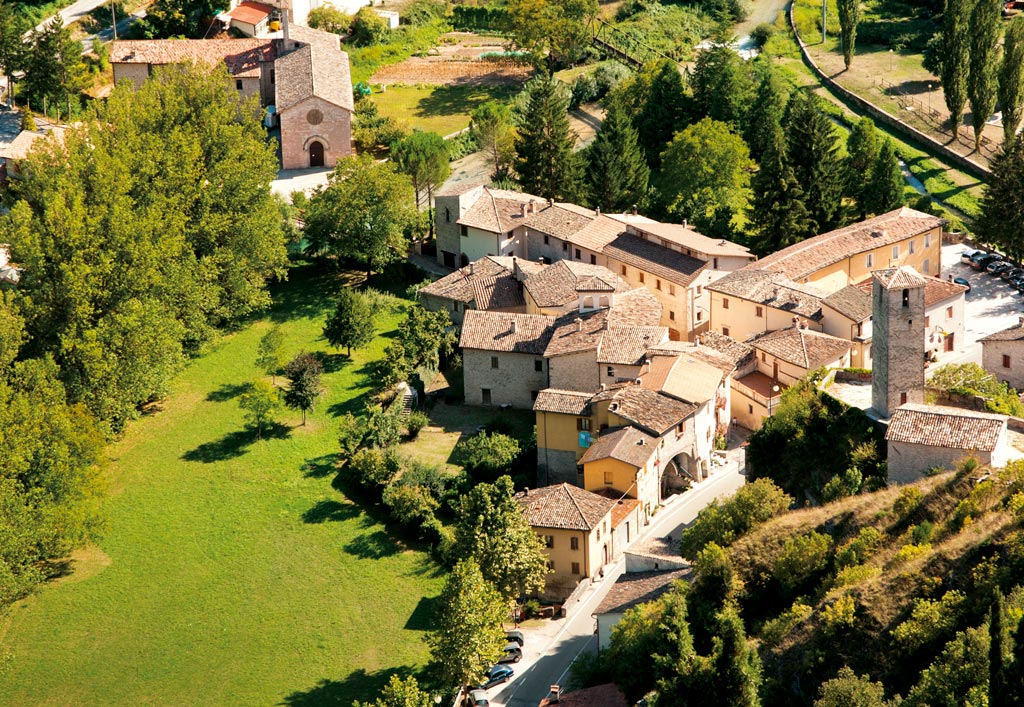The fresco of the Arbor Vitae in the church of San Lorenzo in Borgo Cerreto di Cerreto di Spoleto.
The theme was well known to Franciscan spirituality and is influenced both by the Lignum Vitae of San Bonaventura where the motif of the Tree of Life of Paradise and the cross of Christ are fused, and by the influence of the Arbor Vitae Crucifixae Jhesu Christi, a work of 1305 by Fra Ubertino da Casale. The paintings of Borgo Cerreto show both the torment of suffering and death expressed by Christ on the cross and by the mourners, and the hope and will not to give in to evil, expressed by the tree of life, with the allusion to Ezekiel’s prophecy on the dry bones and the tree of Jesse that comes back to life.

To understand what they meant to those who faced them, it is necessary to contextualize them in the difficult historical moment that was being experienced at that time: there were fights between factions everywhere, rivalries between cities and castles, which often resulted in cavalcades, that is, in the burning of crops and therefore in the consequent hunger and greater vulnerability to disease, already favored by the habitual lack of hygiene.
To this were added other factors not due to human will, such as earthquakes and the plague. On April 30, 1279, the earthquake hit the areas of the Apennines. On that occasion in Cerreto di Spoleto the council met outdoors. According to Sansi, who reports the news to us, this choice was due both to safety reasons and to the fact that the buildings had suffered damage and no one felt like staying in a closed environment. Twenty years later, in 1298, the earthquake hit Spoleto and the surrounding areas. In 1328 the earthquake was devastating in Norcia and the surrounding towns: houses, towers, churches and parts of the walls collapsed and there were countless deaths. This disaster impressed the popular imagination: Paolo Rocchi, from Cascia, speaking of the earthquake of 1599 still refers to that of 1328. Among the towns hit by the earthquake of 1328 that suffered serious damage were Cerreto di Spoleto and Preci where, according to Villani, due to the collapse of the “castle”, not only all the inhabitants died but even the animals, and perhaps this is where the Spoleto saying “ji preci” originates, meaning “to go to ruin”.

To make matters worse, in 1348 the plague spread, which remained endemic for three centuries, as we are witnessed more than by documents by the images of the patron saints of this calamity, in particular San Rocco and San Sebastiano, who covered the walls of the churches throughout Valnerina like an obsession, testifying to the impotence of the populations in the face of such a scourge. The reaction manifested itself in opposite ways: some fearing the uncertainty of the future wanted to enjoy the present to the fullest, others exasperated the sense of the transience of life. In the past, death was seen with relative serenity, as a foreseen, controllable and manageable reality.

In that historical context of disease and violence, the sense of guilt, sin and the afterlife was exacerbated with the terror of damnation and the search for suffrage while one was still alive, no longer being able to rely on children or relatives since many parents had the thankless task of having to bury their children struck down by the disease before dying themselves having contracted the contagion.
In that tragic historical and social reality, the arbor vitae, like the one frescoed in the Church of San Lorenzo, indicated that even the dry tree can send out new shoots and that life can come from death: an invitation to hope and not to be overwhelmed by anguish: it is a hymn to life and trust as the Easter hymn Fulget crucis mysterium! says!
Latest posts by Paolo Aramini (see all)
- The Arbor Vitae, when art is an invitation to discover Valnerina - July 8, 2025
- Exploring Montefranco in the footsteps of San Bernardino da Siena - June 12, 2025
- Sellano: vici, pagi and castles - May 20, 2025

